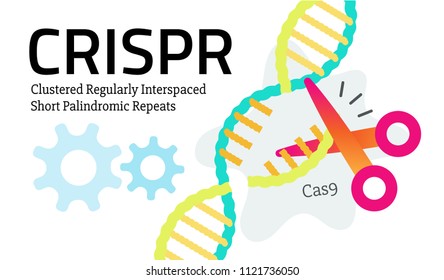CRISPR-Cas9 for Sickle-Cell Anaemia
~Preet

The writer or publisher has no rights to this image. This image is taken from crisprcas9-genome-editing-technology-that-260nw-1121736050.jpg
In 2021, India will launch a five-year initiative to produce Clustered Regularly Interspaced Short Palindromic Repeats (CRISPR) to treat sickle cell anaemia. In India, sickle cell anaemia is the first illness targeted for CRISPR-based treatment. The pre-clinical phase (animal studies) is set to commence. CRISPR (Clustered Regularly Interspaced Short Palindromic Repeats) is a gene editing system that uses a specific enzyme called Cas9 to mimic bacteria's natural defence mechanism against viral assaults. It generally entails the insertion of a new gene or the silencing of an existing gene via a process known as genetic engineering. CRISPR technique does not entail the insertion of any new genes from outside sources. CRISPR-Cas9 technology is frequently referred to as 'Genetic Scissors.' Its method is sometimes equated to the 'cut-copy-paste' or 'find-replace' functions in standard computer programmes. A faulty stretch in the DNA sequence that causes sickness or dysfunction is identified, cut, and deleted, and then replaced with a 'right' sequence. Biochemical techniques, such as particular protein and RNA molecules, are utilised to do this. The technique mimics a natural defence mechanism used by some bacteria to protect themselves against viral assaults.
The first step is to pinpoint the specific gene sequence that is causing the problem. After that, an RNA molecule is instructed to locate this sequence on the DNA strand, much like a computer's 'find' or'search' function. Cas9 is then utilised to break the DNA strand at specified locations and delete the incorrect sequence. When a DNA strand is damaged, it has a natural tendency to re-attach and repair. However, if the auto-repair process is allowed to run its course, the problematic sequence may reappear. Scientists help the auto-repair process by providing the right sequence of genetic instructions that connect to the damaged DNA strand. It's like removing the faulty section of a lengthy zipper and replacing it with a regularly functional section. The entire process is programmed and extremely efficient, albeit the possibility of mistake cannot be completely eliminated.
CRISPR contributes to illness therapy by fixing the underlying genetic issue. CRISPR-based therapeutic options are not available as pills or drugs. Instead, some cells are removed from each patient, the genes are altered in the laboratory, and the repaired genes are then re-injected into the patients. What and where to alter varies depending on the situation. As a result, each sickness or ailment that has to be treated requires a unique remedy. Because genes are involved, the solutions may be distinctive to a given population or racial group. Changes in genetic sequences are retained by the person and are not handed down to offspring.
Many illnesses and disorders are genetic in nature, meaning that they are caused by undesirable alterations or mutations in genes. These include common blood problems such as sickle cell anaemia, eye diseases such as colour blindness, cancers of many sorts, diabetes, HIV, and liver and heart ailments. Many of these are also inherited. CRISPR provides the door to discovering a lasting therapy for many of these disorders. Anomalies in gene sequences cause deformities such as stunted or sluggish development, communication difficulties, and the inability to stand or walk. CRISPR offers a possible therapy for such problems as well.
CRISPR has the ability to cause profound changes in individuals, which might be exploited. A Chinese researcher revealed in 2018 that CRISPR assists in illness therapy by fixing the underlying genetic defect. This was the first reported occurrence of a 'designer baby,' and it sparked great worry among scientists. Preventive treatments to achieve particular features are not something scientists now intend to employ the technology for. Furthermore, because the alterations were performed in the embryo, the newly acquired characteristics were likely to be handed down to future generations. Though the technique is generally accurate, it is not perfect and may cause a few mistakes, causing alterations in other genes. This has the potential to be passed on across generations.
Comments
Post a Comment